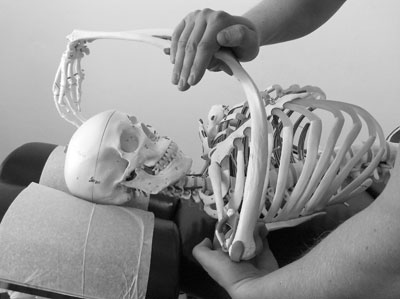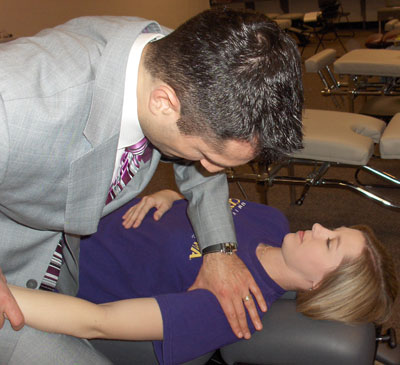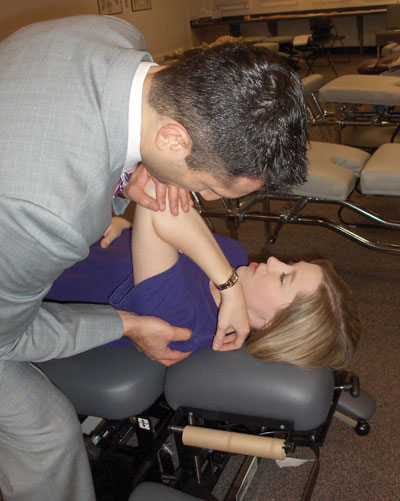
An individual presents to your office complaining of anterior shoulder pain.
Sample Case
An individual presents to your office complaining of anterior shoulder pain. The patient informs the doctor that the shoulder injury began following an abrupt fall on the ice three weeks ago. She mentions that she was walking to her car late one evening, when she unknowingly stepped onto a piece of ice, which made her slip and fall backwards. The fall was quick, but she still managed to extend her arm to break her fall.
 |
|
| Photo 1: Anterior humerus contacts are displayed on the skeletal model. Advertisement
|
However, when she landed backwards onto her arm, she felt an immediate pain in the anterior compartment of her shoulder, and the pain has not dissipated since. Physical exam reveals subluxations present at C5-C6, as well as the right sacral base. Further examination reveals that the affected arm cannot circumduct fully, and that the pain is exacerbated in 60-120 degrees of abduction. Radiological and neurological exams are normal.
This sample case points to an issue with the glenohumeral (GH) joint. Would you be comfortable detecting and correcting humeral subluxations along this joint? In this edition of Technique Toolbox, we will look at how the humerus can subluxate, and how to correct for an anterior humerus subluxation.
Before we begin with analyzing the shoulder, I need to emphasize that the doctor must detect and correct all subluxations of the spine first, prior to adjusting the shoulder. Let us always be mindful that correcting the spine will always produce a greater neurological effect than correcting any extremity, so please adjust the spine prior to any extremity work.
A little anatomy and biomechanics review of the GH joint
When a humeral subluxation through the GH joint is present, the patient presents with shoulder pain between 60 and 120 degrees of abduction, further aggravated by medial and lateral rotation. The doctor must comprehend that the pain is exacerbated in the 60-120 degree arc, because as the humerus subluxates, the greater tubercle of the humerus collides with the acromial hood. This collision results in the compression of two structures: the supraspinatus tendon and the subacromial bursa.
In order for the humerus to move through the GH Joint properly, three motions must take place:
- rotation (Picture a tire spinning in the mud.)
- rolling (Picture a tire moving normally across the pavement.)
- translation (Picture a tire braking on ice. The tire stays stationary, but slides.)
 |
|
| Photo 2. Anterior humerus contacts are displayed on the patient.
|
The humerus must be able to perform all three of these motions during abduction, to provide the greater tubercle proper clearance from the acromion process. If one or more of the three motions are impeded, the result will lead to impingement of the supraspinatus tendon and the subacromial bursa.
The doctor must be aware that if the shoulder pain is due to contact injury, then an X-ray is required to rule out fracture, instability or dislocation. No adjusting of the joint should be performed until this is completed.
So how do we detect and correct this problem?
STEP ONE: ANALYSIS
- The patient presents with anterior shoulder pain, a loss of strength abducting the involved arm, and cannot circumduct the affected arm fully during physical examination.
- The patient reveals that he/she fell posteriorly on an outstretched arm, or unknowingly tried to pull open something that was locked or secured.
- For example, a typical clinical scenario may be that the patient had attempted to pull open an icy car door, which did not give way, resulting in an immediate pain in the anterior aspect of the shoulder. Or, as in our sample case, the patient slipped on an icy patch and fell backwards onto her outstretched arm.
- To confirm that the patient indeed has an anterior humerus subluxation, the doctor must perform an anterior deltoid muscle test:
- Patient: Supine, arms at 90
- degrees, palms facing caudad.
- Doctor: At the head of the table.
- Procedure: Doctor applies caudad pressure to the patient’s extended arms, and will instruct the patient to resist, keeping the arms at 90 degrees.
- Normal: If an anterior humerus subluxation is not present, the patient will be able to resist the doctor’s pressure, and keep the arms at 90 degrees.
- Subluxation: If the patient is unable to resist the doctor’s caudad pressure, and breaks the 90-degree position of the arms, this confirms that the humerus has subluxated anteriorly.
- 4. Anterior deltoid muscle testing confirms that the subluxation is an anterior humerus, whereby the humeral head has translated in an anteriorposition.
STEP TWO: CORRECTION: SUPINE ANTERIOR HUMERUS ADJUSTMENT (SEE PHOTOS 1 AND 2)
- Patient: Supine, affected shoulder and elbow flexed to 90 degrees.
- Doctor: On affected side, facing cephalad.
- Table: Dorsal piece or toggle board under the affected shoulder in the ready position.
- Contact: Palmer contact on affected side elbow.
- Stabilization: Humeral Head.
- LOC: A-P. Repeat 1-3 times.
ALTERNATIVE CORRECTION IF THE PATIENT CANNOT FLEX SHOULDER AND ARM
(SEE PHOTO 3)
- Patient: Supine, affected arm straight.
- Doctor: On affected side, facing cephalad.
- Table: Dorsal piece or toggle board under the affected shoulder in the ready position.
- Contact: Web contact on the humeral neck.
- Stabilization: Distract the affected arm.
- LOC: A-P. Repeat 1-3 times.
 |
|
| Photo 3: Anterior humerus alternative adjustment contacts are displayed.
|
Following the correction of the subluxated humerus, the doctor can refer the patient to a massage therapist for soft tissue work on the anterior deltoid. If the doctor prefers to perform the soft tissue work on the anterior deltoid themselves, they are more than welcome to do so.
As usual, I have only scratched the surface in adjusting the shoulder. There are seven articulating segments that make up the shoulder complex, and several subluxations that can occur at each articulation. When an anterior humerus is present, the glenohumeral articulation is affected, and must be corrected accordingly. If you have any questions or concerns, please contact me at johnminardi@hotmail.com.
Until next time . . . Adjust with Confidence!
Dr. John Minardi is a 2001 graduate of Canadian Memorial Chiropractic
College. A Thompson-certified practitioner and instructor, he is the
creator of the Thompson Technique Seminar Series and author of The
Complete Thompson Textbook – Minardi Integrated Systems. In addition to
his busy lecture schedule, Dr. Minardi operates a successful private
practice in Oakville, Ontario. E-mail johnminardi@hotmail.com, or visit www.ThompsonChiropracticTechnique.com .
Print this page